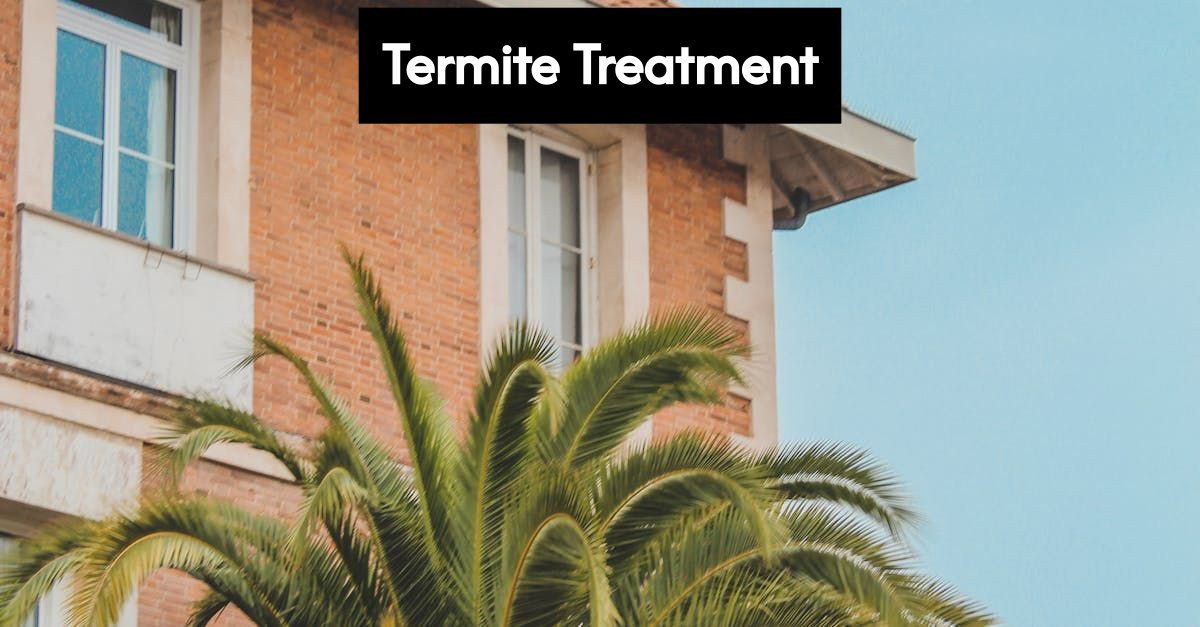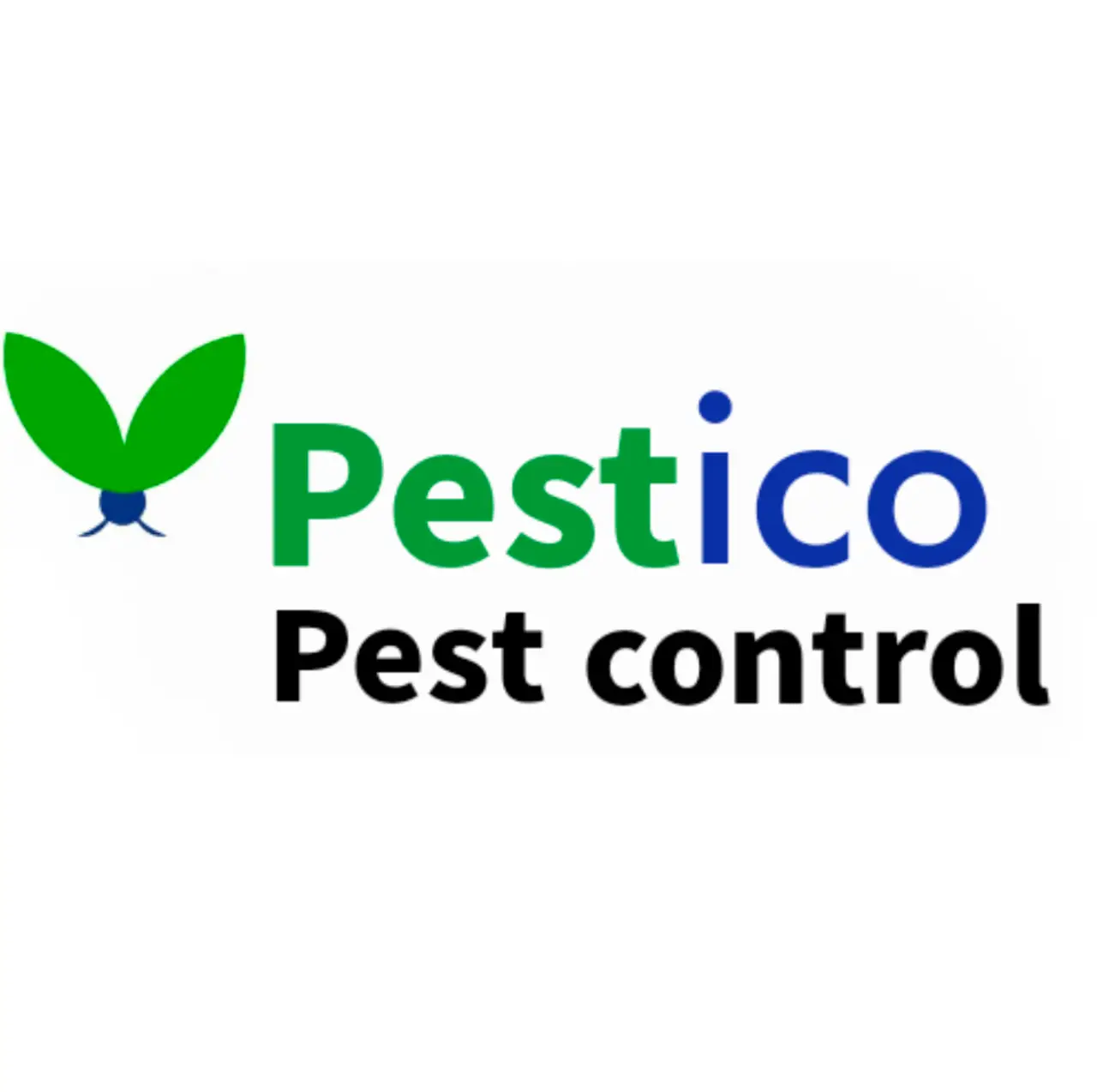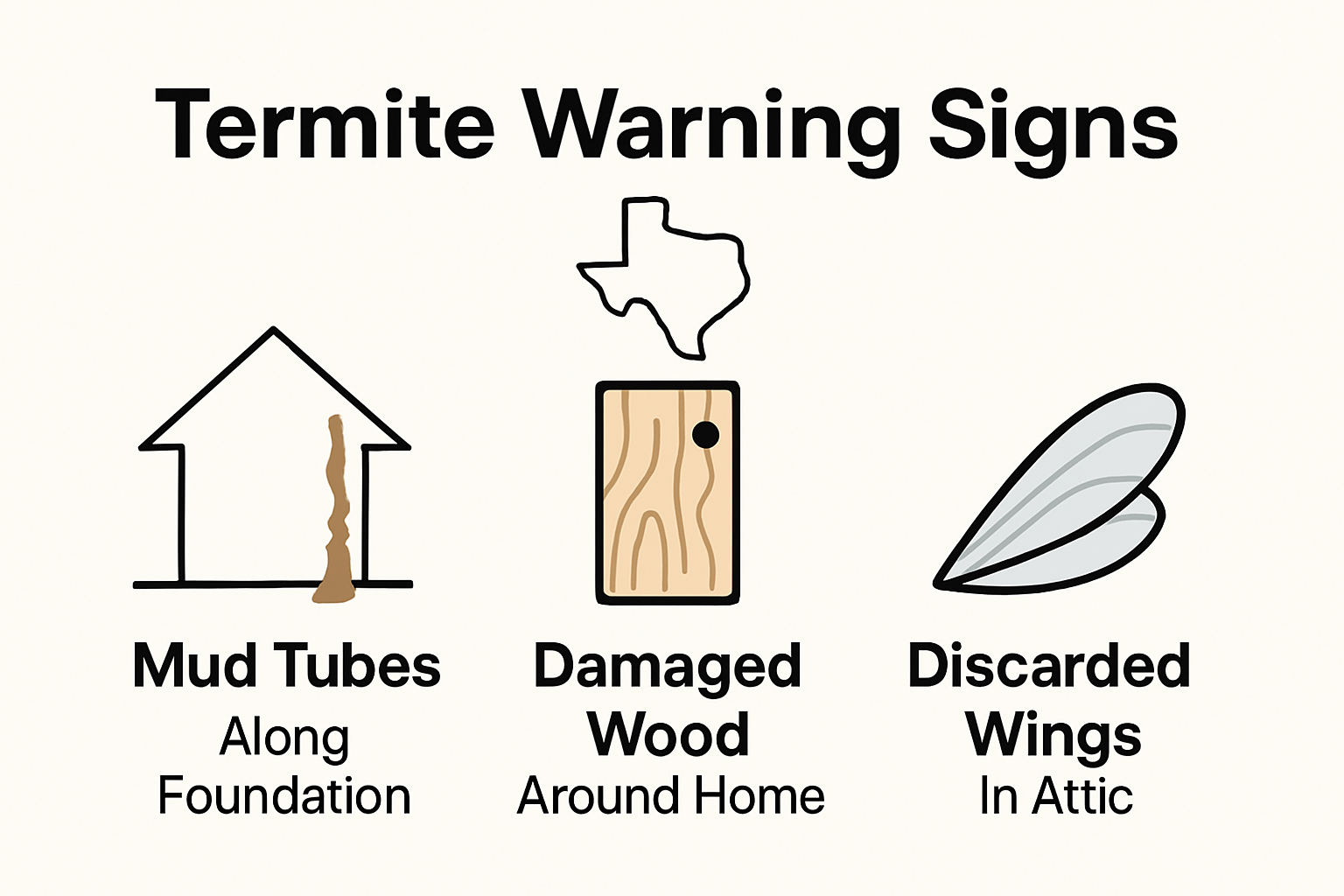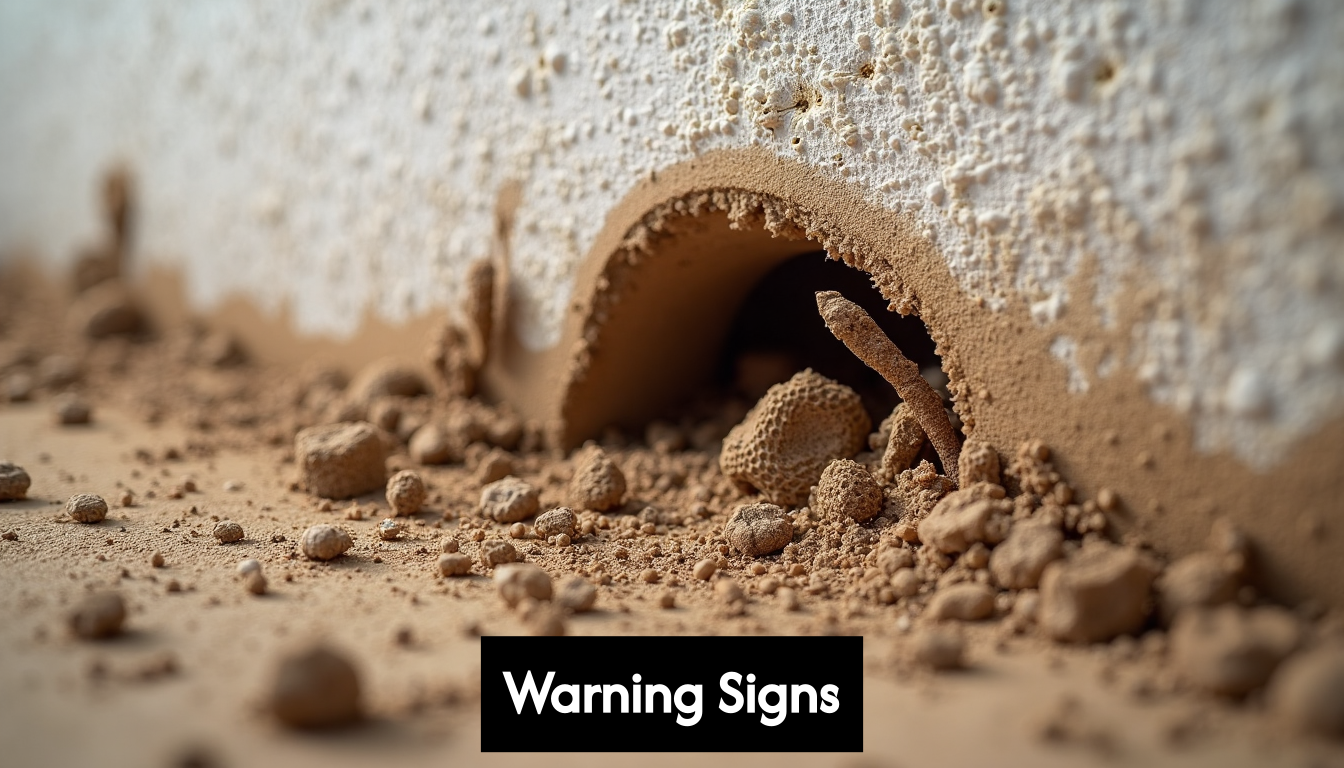
Texas homes face one of the most relentless threats in the country from termites, with annual treatment costs ranging from $290 to $1,150 depending on the extent of the infestation and property size. Most people worry about visible mud tubes or damaged wood, but surprisingly, termites can cause thousands of dollars in damage before you ever spot a single sign on your walls or floors. Early warning signs are just the tip of the iceberg—professional detection often uncovers hidden colonies that have been silently undermining your investment for years.
Table of Contents
- Signs You Need Termite Treatment Options
- Popular Termite Treatment Options Explained
- Choosing The Right Solution For Your Property
- Tips For Preventing Future Termite Infestations
Quick Summary
| Takeaway | Explanation |
|---|---|
| Recognize visual warning signs of termite activity | Look for mud tubes, hollow-sounding wood, and unusual cracks or bubbling paint as signs of termite infestation to address issues early and prevent costly damage. |
| Consider professional assessments for early detection | Regular professional inspections can identify termite activity before visible damage occurs, allowing for targeted treatment and potentially saving thousands in repairs. |
| Choose the right treatment based on property characteristics and termite species | Tailor your termite treatment approach based on your property’s specific features and the type of termite colony present to ensure effective control. |
| Implement moisture management as a prevention strategy | Proper drainage, prompt repair of leaks, and regular inspections greatly reduce the risk of attracting termites by addressing their preferred damp environments. |
| Invest in long-term prevention and monitoring | Ongoing professional monitoring and maintenance, including regular inspections and preventative treatments, are essential for maintaining protection against future termite infestations. |
Signs You Need Termite Treatment Options
Termite infestations can silently destroy your property before you even realize they are present. Recognizing early warning signs is crucial for protecting your home or business from extensive and costly structural damage. Texas homeowners must stay vigilant and understand the specific indicators that signal an urgent need for professional termite treatment options.
Visual Warning Signs of Termite Activity
Termites leave behind distinctive evidence of their presence that attentive property owners can identify. Mud tubes are perhaps the most telling sign of termite infestation. These thin, mud-like tunnels typically appear along foundation walls, concrete slabs, or wooden structures. These tubes serve as protective passageways for subterranean termites traveling between their underground colonies and food sources.
Wooden structures exhibiting unusual characteristics can also indicate termite damage. Hollow-sounding wood when tapped, unexplained cracks or bubbling paint on wooden surfaces, and wood that appears damaged or weakened are critical red flags. According to research from Full Scope Pest Control, these signs suggest active termite colonies might be compromising your property’s structural integrity.
Subtle Indicators of Hidden Termite Presence
Some termite warning signs are less obvious but equally significant. Discarded wings near windows, doors, or other entry points often indicate a termite swarm has recently occurred. These small, translucent wings are typically shed by reproductive termites during their mating season. Finding these wings suggests a mature colony is establishing new territories in or around your property.
Moisture issues and wood-to-ground contact create ideal conditions for termite infestations. Experts recommend regular inspections of areas where wood touches soil, checking for water leaks, and maintaining proper ventilation to reduce termite attraction. Pay special attention to areas with consistent dampness, such as crawl spaces, basements, and areas around plumbing fixtures.
Professional Assessment and Early Detection
While homeowners can recognize some signs, professional termite inspections provide the most comprehensive assessment. Advanced monitoring systems can detect termite activity before visible damage occurs, allowing for more targeted and efficient treatment. Learn more about our approach to early termite detection.
Timely identification of termite activity can save thousands of dollars in potential repair costs. If you notice any of these signs or suspect termite presence, contact a professional pest control service immediately. Early intervention is key to preventing extensive structural damage and protecting your property’s value.
Popular Termite Treatment Options Explained
Homeowners and businesses in Texas face numerous challenges when addressing termite infestations. Understanding the most effective termite treatment options can help property owners make informed decisions about protecting their valuable investments. Each treatment method offers unique advantages and targets specific types of termite colonies.
Chemical Barrier Treatments
Chemical barrier treatments represent one of the most traditional and reliable approaches to termite control. According to Texas A&M University research, these treatments involve creating a continuous chemical barrier around structures through specialized techniques like trenching and sub-slab injection. Professional pest control technicians apply liquid termiticides into the soil surrounding a property, creating a protective zone that prevents termites from entering or moving between underground colonies and structures.
Modern termiticides are designed to be both repellent and non-repellent. Repellent chemicals create an immediate barrier that termites cannot cross, while non-repellent solutions allow termites to pass through treated areas and inadvertently transfer the chemical to other colony members. This approach ensures comprehensive elimination of entire termite populations.
Baiting Systems
Baiting systems offer a more targeted and environmentally conscious approach to termite treatment. These systems involve strategically placing monitoring stations around a property that contain wood or cellulose materials mixed with slow-acting termite-specific toxicants. Termite workers discover these bait stations and carry the poisoned material back to their colonies, gradually eliminating the entire population.
The primary advantage of baiting systems is their precision and reduced environmental impact. Unlike broad chemical treatments, baiting systems focus on specific termite colonies and minimize widespread chemical dispersion. Learn more about our advanced pest management strategies.
Integrated Treatment Approaches
Professional pest control services increasingly recommend integrated treatment approaches that combine multiple strategies for maximum effectiveness. This might include initial chemical barrier treatments followed by ongoing monitoring and baiting systems. Such comprehensive approaches address both immediate termite threats and provide long-term prevention.
Integrated treatments also involve identifying and eliminating moisture conditions and wood-to-ground contact that attract termites. Professionals may recommend structural modifications, drainage improvements, and regular inspections to create an environment less conducive to termite infestations.
Choosing the right termite treatment depends on multiple factors including the specific termite species, extent of infestation, property characteristics, and environmental considerations. Professional pest control experts can conduct thorough assessments to determine the most appropriate treatment strategy for your unique situation. Investing in professional termite treatment not only protects your property but can potentially save thousands in potential structural repair costs.
Choosing the Right Solution for Your Property
Selecting the most appropriate termite treatment for your property requires careful consideration of multiple factors. Each Texas home and business presents unique challenges that demand a tailored approach to termite control. Understanding the key elements that influence treatment selection can help property owners make informed decisions and protect their valuable investments.
Assessing Property Characteristics
The specific characteristics of your property play a crucial role in determining the most effective termite treatment. Research from Brady Pest Control indicates that treatment costs in Texas typically range from $290 to $1,150, depending on the property’s size, complexity, and infestation severity. Factors such as building construction, foundation type, landscape features, and existing moisture conditions significantly impact treatment strategy.
Wooden structures with direct ground contact, older buildings with multiple entry points, and properties with extensive landscaping near foundations require more comprehensive treatment approaches. Professional pest control experts conduct thorough property assessments to identify potential termite vulnerabilities and recommend targeted solutions that address specific structural and environmental challenges.
Tailoring Treatment to Termite Species
Texas is home to multiple termite species, each requiring unique treatment strategies. Subterranean termites, the most common and destructive variety, demand different approaches compared to drywood or dampwood termites. Full Scope Pest Control experts recommend a comprehensive evaluation that includes species identification, colony size assessment, and targeted treatment methods.
Modern termite control offers multiple solution types, including liquid termiticides for soil barriers, advanced bait systems like Sentricon for colony elimination, and eco-friendly non-invasive treatments. Learn more about our specialized pest management approaches.
Long-Term Prevention and Monitoring
Successful termite management extends beyond initial treatment. Preventive measures and ongoing monitoring are critical for long-term property protection. According to expert recommendations, integrated strategies should include:
- Regular professional inspections
- Moisture control to reduce termite attraction
- Structural modifications to eliminate potential entry points
- Advanced monitoring systems for early detection
Property owners should view termite treatment as an ongoing process rather than a one-time solution. Professional pest control services can develop customized maintenance plans that provide continuous protection and early intervention.
Ultimately, the right termite treatment solution balances effectiveness, cost-efficiency, and minimal property disruption. Consulting with experienced pest control professionals who understand local termite behaviors and Texas-specific environmental conditions ensures the most comprehensive protection for your property. Investing in professional assessment and targeted treatment can save thousands in potential structural damage and provide peace of mind for homeowners and business owners alike.
Tips for Preventing Future Termite Infestations
Preventing termite infestations requires a proactive and comprehensive approach that addresses multiple potential entry points and environmental conditions. Texas homeowners and businesses can significantly reduce their risk of termite damage by implementing strategic prevention methods that create less hospitable environments for these destructive insects.
Moisture Management and Structural Maintenance
Research from pest control experts highlights the critical importance of moisture control in termite prevention. Termites are attracted to damp environments, making proper drainage and moisture management essential. Homeowners should focus on several key areas:
- Ensure proper grading around the foundation to direct water away from the structure
- Repair leaking pipes, faucets, and air conditioning units promptly
- Maintain clean and functional gutters and downspouts
- Seal any cracks or openings in the foundation
Regular inspections of crawl spaces, basements, and areas with wood-to-ground contact can help identify potential moisture issues before they become significant problems. Learn more about local pest prevention strategies.
Innovative Wood Protection Techniques
Modern termite prevention goes beyond traditional methods. Emerging research from Modern Sciences highlights innovative approaches like bistrifluron-treated wood, which offers a promising eco-friendly solution. This treatment disrupts termite molting processes, potentially leading to colony collapse while minimizing environmental impact.
Additional wood protection strategies include:
- Using pressure-treated lumber for outdoor structures
- Avoiding wood-to-soil contact in landscaping
- Removing dead tree stumps and wood debris from around your property
- Storing firewood away from the main structure
Regular Professional Monitoring
Professional pest control services provide the most comprehensive approach to long-term termite prevention. Implementation of physical barriers during construction or renovation offers significant protection. Regular maintenance schedules allow experts to:
- Conduct thorough property inspections
- Identify potential vulnerabilities
- Apply preventive treatments
- Monitor for early signs of termite activity
Homeowners should consider annual professional inspections, especially in Texas, where termite activity is prevalent. These inspections can catch potential issues before they develop into full-blown infestations, potentially saving thousands in potential structural damage.
Effective termite prevention is an ongoing process that requires attention to detail and a multi-faceted approach. By combining moisture management, innovative protection techniques, and professional monitoring, property owners can create a robust defense against these destructive pests. Remember that prevention is always more cost-effective than treating an extensive termite infestation.
Frequently Asked Questions
What are the signs of a termite infestation?
Look for visible signs like mud tubes, hollow-sounding wood, and cracks or bubbling paint. Additionally, discarded wings near entry points can indicate a mature termite colony.
How much does termite treatment cost in Texas?
Annual treatment costs in Texas typically range from $290 to $1,150, depending on the extent of the infestation and the size of the property.
What are the most effective termite treatment options available?
Effective treatments include chemical barrier treatments, baiting systems, and integrated approaches that combine multiple methods for maximum effectiveness.
How can I prevent future termite infestations?
Prevent infestations by managing moisture, performing regular inspections, using pressure-treated wood, and implementing professional monitoring systems.
Take Action Against Texas Termite Threats—Get Peace of Mind Today
You read in our guide how termites can silently destroy your home or business, leaving you stressed by hidden damage and costly repairs. Finding mud tubes, hollow wood, or even just unexplained cracks can feel overwhelming. You want a solution that actually prevents severe structural issues and brings back your confidence as a property owner.
Let a trusted family-owned team quickly assess and protect your investment. Visit Pestico today to schedule a professional termite inspection. Experience the highest quality of service at affordable prices from local experts who care. When every day counts, don’t wait for termites to take over—get in touch with Pestico now and reclaim the safety of your property. You deserve to feel secure and stress-free knowing your home or business is in expert hands.
Recommended Articles
- Affordable Pest Control Options For Texas Homeowners In 2025 – Pest Control Van Alstyne, TX – Pestico Pest Control
- Understanding The Difference Between Pest And Termite: 2025 Guide For Texas Homeowners – Pest Control Van Alstyne, TX – Pestico Pest Control
- Top Signs You Need Pest Treatment: Texas Homeowner Guide 2025 – Pest Control Van Alstyne, TX – Pestico Pest Control



